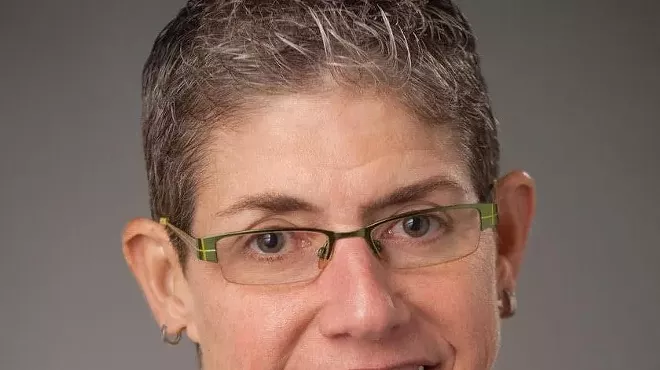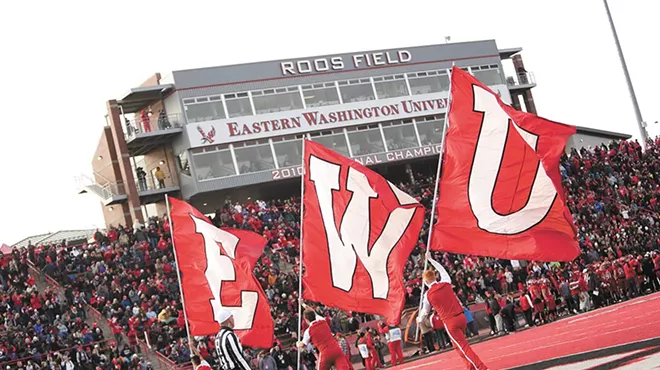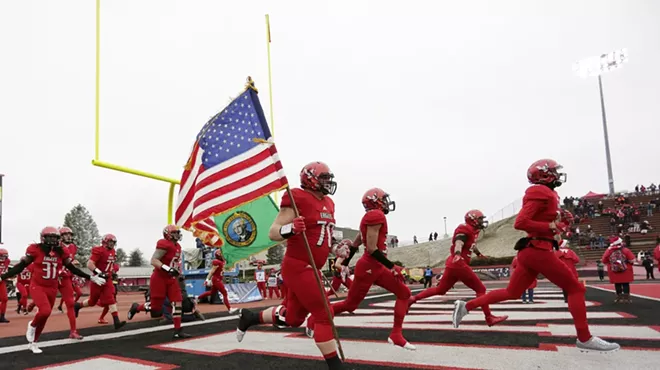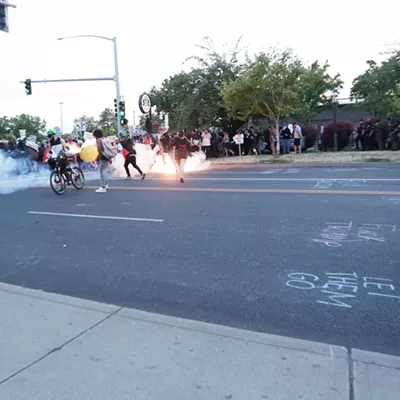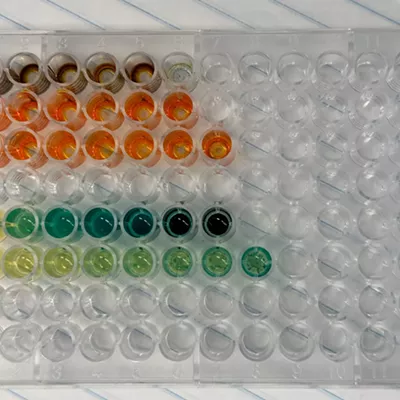
The report analyzed the cost of the athletics program to be around $12 million to $14 million per year, but says it has had "no positive impact on our student enrollment, retention or recruitment." It was commissioned by the faculty senate and has been sent to the EWU administration, including President Mary Cullinan. At the end of the month, it will be presented to the EWU Board of Trustees.
An EWU spokesman says between now and then, it will be "reviewing the report to assess the accuracy of the data/statistics provided."
David Syphers, an assistant professor of physics at EWU and an author of the report, tells the Inlander that he hopes the report can "start a conversation" with the athletics department and administration regarding the options to cut costs within the athletics department.
"We view this report as the beginning," Syphers says. "It's not an endpoint."
Eliminating the athletics department was just one of many suggestions laid out as an "alternative model" for athletics. The others include imposing budget cuts on athletics, eliminating only football, or transitioning to the National Association of Intercollegiate Athletics, NCAA Division II or Division III.
EWU has seen dwindling enrollment in recent years, forcing the university to approve a $3.6 million budget cut in June of last year for 2020. Syphers says that because of the budget cuts, faculty have been interested in looking at what the benefits of the athletics department are, considering it's a large part of the budget.
The faculty report says that it "aims to weigh the costs and benefits of funded varsity intercollegiate athletics" at EWU. In 2019, EWU athletics spent $18.3 million, and $13.5 million came from the university through either direct institutional support, student fees or indirect institutional support. (That $18.3 million is a little bit inflated, however, since that was during the football team's run to the national championship game.)
"This means 74 percent of the budget of athletics is money coming from the institution that could be spent elsewhere," the report says, in addition to an extra $2 million per year allocated to the department.
And the report's analysis says that despite EWU's football success last decade, it has had no impact on enrollment or retention.
"Athletics has benefits," it says. "But so do those areas of the university being deprived of funds."
Lynn Hickey, the director of athletics at EWU, says she respects the work of the faculty and their interest in the university. She says they're currently reviewing the report to see where they differ with the findings.
"I think what you've got to be careful about when you see a report like this is that just putting together a narrative around numbers that you pull from charts and graphs can be interpreted in different ways, without maybe the full context of the program and how we fit in the university and community," Hickey tells the Inlander.
Hickey says that every program in the country has institutional support and few athletic departments actually make money.
The report does acknowledge that most athletics departments take more money than they generate, but it argues that athletics takes more than peer institutions.
Ticket sales, meanwhile, made up 3.7 percent of expenses of athletics, according to the report, and alumni contributions only made up 4.5 percent. And it argues that there are other needs that should be prioritized before athletics. Faculty is concerned that the university is not replacing retiring faculty members, that there are rising course fees for students, and that the reorganization of certain departments has been a burden.
Syphers says that faculty isn't expecting athletics to become self-sustaining, but perhaps that those who are in charge more closely examine the cost of athletics and the impact it's having on the larger university.
"When we're talking about the benefits of athletics, I understand some of them," Syphers says. "But is that really commensurate with the cost?"
Hickey says there are benefits to athletics that aren't necessarily quantifiable. She points to the fact that a million people watched EWU play in the national championship. And she says that when kids come see EWU games, even if they won't play sports in college, it is often a child's first exposure to a college campus.
"We're kind of the front porch, because oftentimes the first time anyone sees us, sees the university, is through some extracurricular activity," Hickey says. "We understand we're not the whole house, but we can be an asset by getting people on the porch and in the front door."
The report, however, identifies alternatives for the future of EWU athletics. The first option is eliminating the department entirely, which the report says would amount to savings of $11 million to $14 million per year.
In this model, the report says, "Eastern could become a national leader in resisting the ever-increasing costs of intercollegiate athletics, and become widely known for our commitment to academic excellence and controlling student cost burden."
The next three options involve transitioning to the NAIA, an alternative to the NCAA, which could save $7 million to $12 million per year, according to the faculty analysis. Moving to Division III would save the same amount roughly, and becoming a Division II school would save about $5 million to $7 million per year.
The report then examines what would happen if EWU maintained its Division I status, but eliminated football. That would save up to $3.5 million per year. The report calls this a "moral choice."
"This choice would anger a few vocal fans, but would show Eastern as standing up for the principles we publicly espouse: That we are here to help our students learn and successfully launch careers. We are not here to have them trade brain damage for a reduced-cost education," it says.
Another option suggests continuing with the current model, but with large budget cuts. And the seventh option in the report is "business as usual."
"Without a doubt, this is the emotionally easiest approach to take for the next year or two, for the university president and the Board of Trustees," the report says. "However, it will lead to catastrophe long term, and indeed even in the relatively near future."
Hickey says none of these options have been discussed. The athletics department understands that it needs to increase its philanthropic giving and its crowd sizes, but she says it does not happen overnight.
"The Board of Trustees has asked that we be a Division I FCS program," she says. "I was hired to do that and we're going to work very very hard to do that until the Board of Trustees changes their mind."
You can view the full report here:
Athletics Funding FO Report by Wilson Criscione on Scribd



